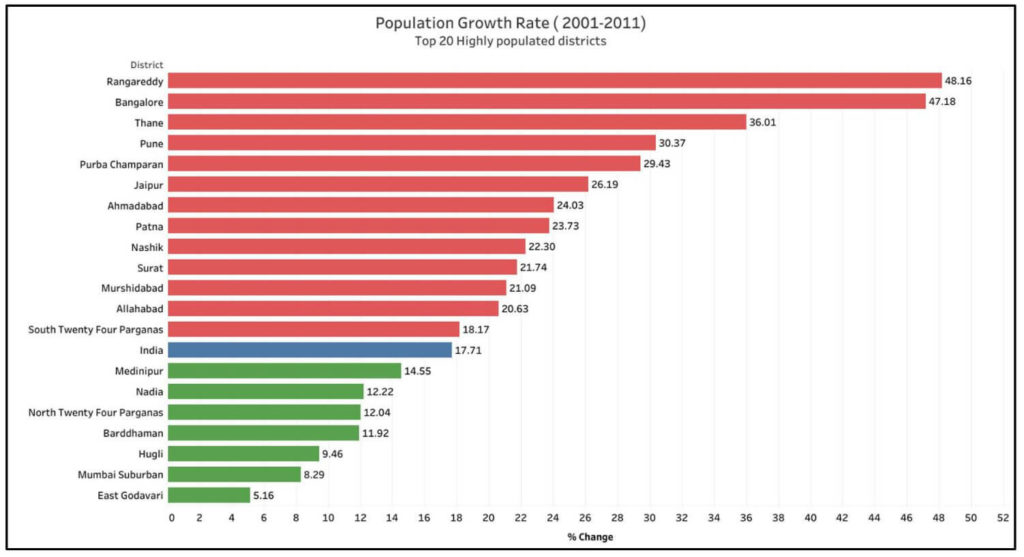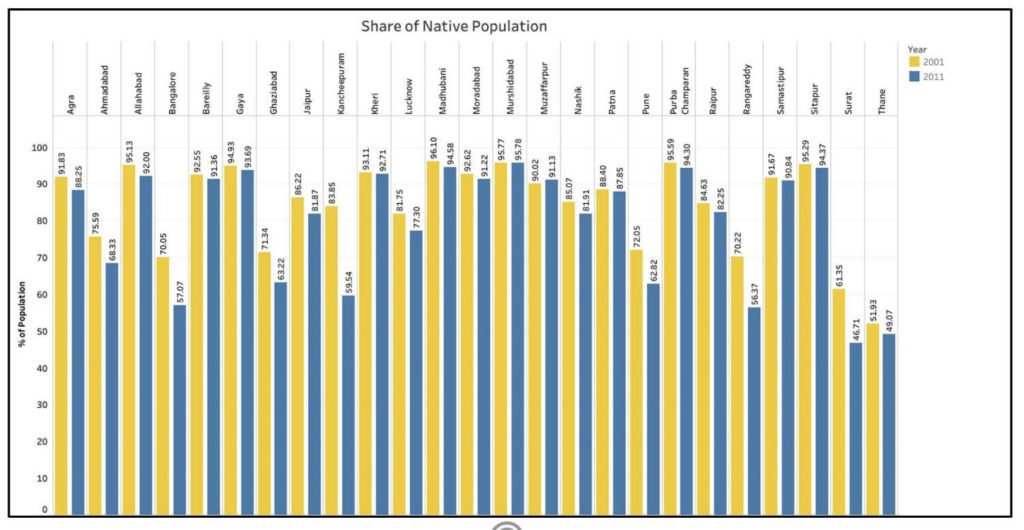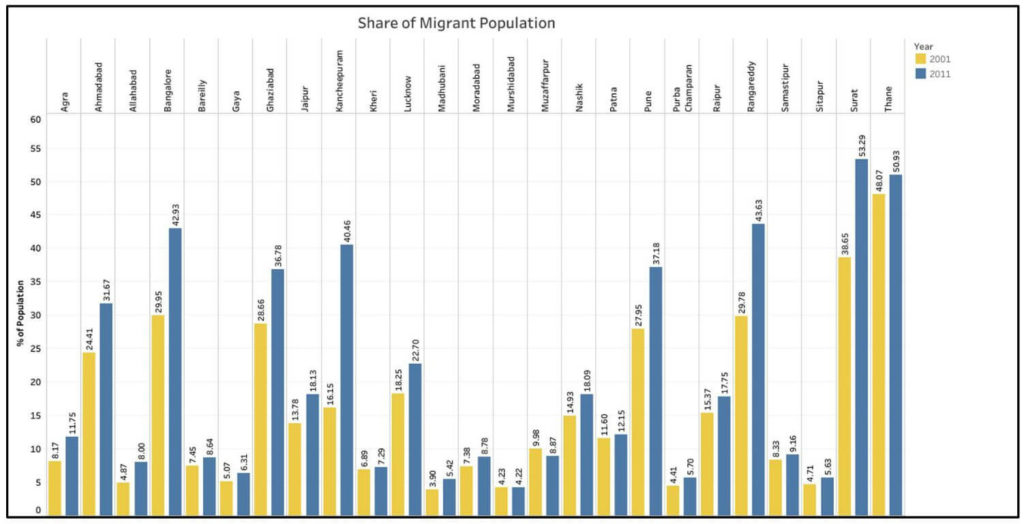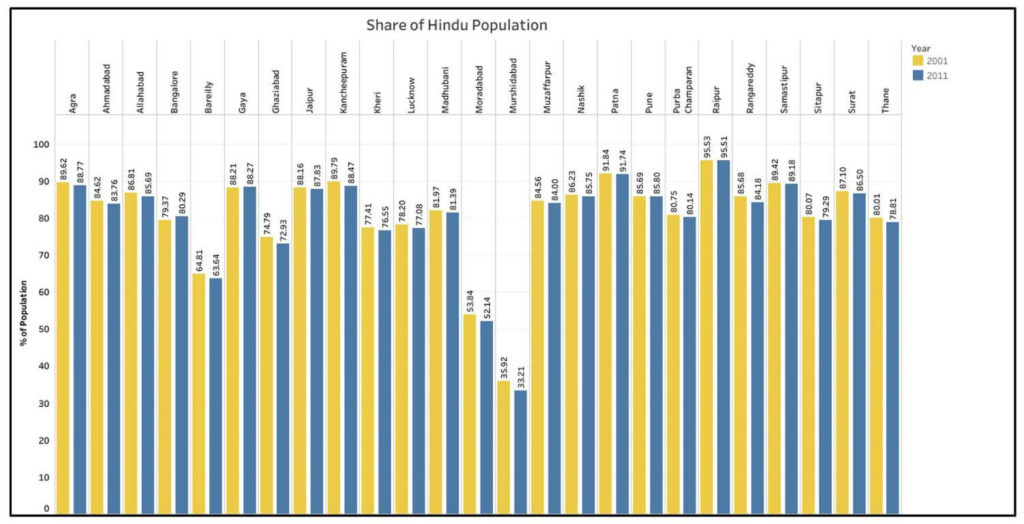[orc]Comparison of population data from the 2001 and 2011 census for some of the highly populated and high growth districts indicates that migrants in urban districts and locals in districts of the Hindi heartland states are the driving factors for population growth.
As highlighted in an earlier story of Factly, the Hindi speaking states have contributed majorly towards the population growth in India. In most of these states, the high population growth is witnessed across districts with more than 2/3rd of the districts registering a population growth rate more than the national average.
There are few districts in these states and few others across the rest of India, where the population growth rate is significantly high. The actual population in these districts is also high which in turn has a significant impact on the overall population growth.
Urban districts are among the highest populated districts with varying population growth rates
Most of the top-20 highly populated districts in India are urban districts. With the exception of few districts, the rest of them registered population growth rates that are significantly higher than the national population growth rate.
The district of Thane, which comprises parts of the India’s most populous city of Mumbai is the largest district by population as per 2011 census. It has a population of 1.1 crores and registered a population growth rate of 36% during the 2001-11 period.
Other districts with large population and have registered a high growth rate include -Bangalore, Pune, Ahmedabad, Murshidabad, Jaipur, Nashik, Surat, Allahabad, Patna, Rangareddy and Purba Champaran. All these districts have registered growth rates that are more than India’s average over 2001-2011 period. With the exception of Purba Champaran, the rest of the districts are Urban centers.
On the other side, there are districts with large population that have registered lower population growth rate compared to the national average. The districts of Medinipur and North Twenty-Four Parganas, which have the 2nd & 3rd largest population in India registered population growth rate of 14.6% and 12.1% respectively. Other highly populated districts with lower population growth include – Mumbai Suburban, Bardhhaman, Hugli, Nadia and East Godavari.
It can be noted that of these districts with lower population growth rate, majority of them (Medinipur, North Twenty-Four Parganas, Bardhhaman, Hugli and Nadia) are in West Bengal and East Godavari in Andhra Pradesh, a reflection of the lower population growth rate in the respective states despite larger population in the district.

Higher migrant population cause for higher population growth rate in major Urban districts
Twenty-five (25) districts with a minimum population of 40 lakh as per the 2011 census and a population growth rate of over 20% were considered for following analysis. Majority of these districts belong to the Hindi heartland states with India’s major urban centers being the exception.
The higher population growth rate observed among the major urban districts correlates with the increase in the share of migrant population. For instance, in 2001, Thane had a ratio of 52:48 for local and migrant population, which as per 2011 census has flipped to 49:51.
Bangalore had a local & migrant ratio of 70:30 in 2001, whereas the share of migrant population has increased to 43% as per the 2011 census. This has resulted in 47% population growth rate over the 2001-11 period.
The district of Rangareddy surrounding Hyderabad has also seen an increase in the share of migrant population from 30% to 44% (this district registered a population growth rate of 48%).
The other urban districts of Pune, Ahmedabad, Surat & Ghaziabad (near New Delhi) have also recorded a substantial growth in share of migrant population which correlates with the substantial increase in respective population growth rates.
The district of Kancheepuram also registered a population growth rate of 39% which is an exception for state of Tamil Nadu. During this period, the share of migrant population has increased from 16% to 40% which explains the high population growth rate.
Unlike in the case of above mentioned districts, the other districts with high population and high growth rates have not seen much of a variance in the local and migrant population ratio. Most of these districts are located in the Hindi heartland states of UP & Bihar and have high share of local population compared to the migrant population. Therefore, the high population growth rates, unlike in the earlier case can be attributed to the increase in the local population. A marginal increase in the share of migrant population is observed in most of these districts.


Less variance in the share of population of the major religions in the highly populated districts.
As per 2001 census, the share of population who identify themselves as Hindu was 80.45% and as Muslim being 13.4%. Christians, Sikhs, Jains and others made up the rest of the population. As per 2011 census, Hindus comprise 79.8% of population and Muslims make up 14.2% of the population. The marginal change reflected at the national level for the respective religions is similarly reflected in the highly populated districts with higher population growth rate.
With the exception of Murshidabad in West Bengal and Moradabad in UP, the rest of the highly populated districts have a majority of Hindu population in line with the national share of Hindu population.
Murshidabad and Moradabad had 35.9% and 53.8% Hindu population in 2001 with share of Muslim population being 63.7% and 45.5% respectively. However, as per the 2011 census, in these two districts, the respective figures for Hindu population are 33.2% and 52.1% and that of Muslim population is 66.3 % and 47.1% respectively. Raipur (95.5%), Patna (91.8%), Agra (89.6%), Samastipur (89.4%), Kancheepuram (89.8%), Gaya (88.2%), and Jaipur (88.2%), have comparatively higher share of Hindu population than the national average as per 2001 Census. They show a marginal variance as per 2011 census with the share of Hindu population as indicated in the chart below.


Population growth rate in the highly populated districts may not be linked to any specific community
There is very little variance in the population share of various religious communities between 2001 & 2011 as far as the highly populated districts are concerned. Further, the difference in growth rates of these communities is in line with the trend of overall population growth rate. Little or no variance between the population share of the respective communities shows that, religious community may not be an influencing factor for population growth, at least in the high population & high growth districts. Initiatives by respective local and state administrations are key in controlling the population growth rates as evident from the southern states. The trend of migration, especially towards urban and semi-urban locations is on the rise and the migrant population is contributing towards the population growth rates as is evident from the data related to the major urban districts.
Featured Image: Migrants in Urban districts



1 Comment
Pingback: Between 2001 and 2011, absolute population of Muslims & Christians in the 0-9 age group increased while that of Hindus decreased - Fact Checking Tools | Factbase.us